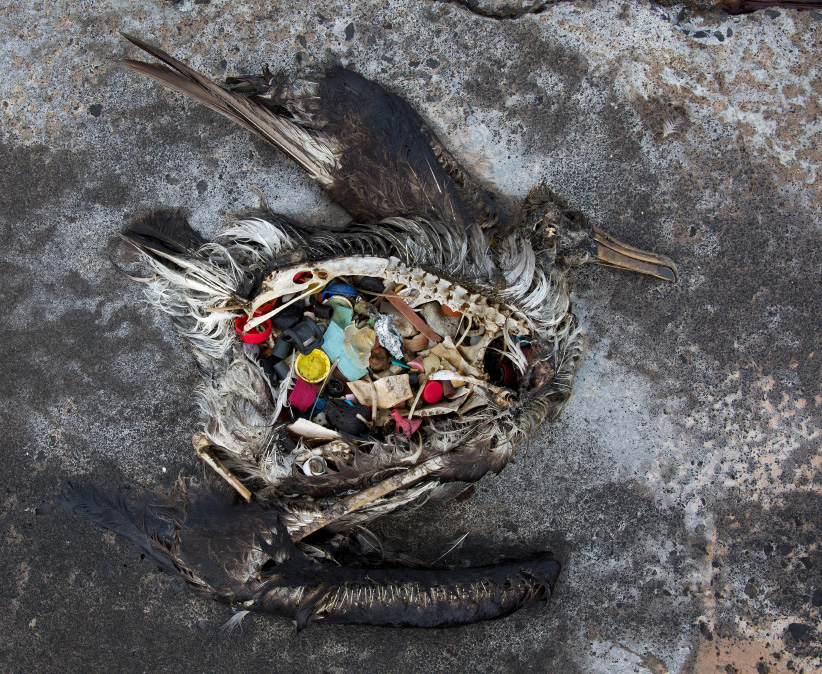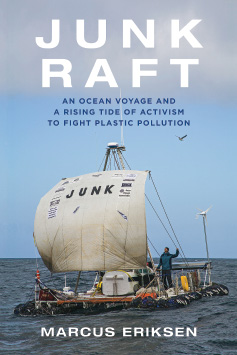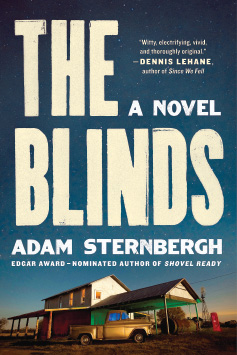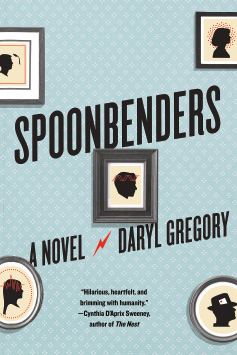The five books everyone is talking about this August
Books to read this month: in fiction and non-fiction, ripping tales of fraud, deceit, murder and (environmental) mayhem on the high seas
Share

This month in book reviews: A town of murderers, a family of psychics, sailing through an ocean choked by garbage, a massive wine con and a philosophical murder mystery. Read more below and check out the rest of our book reviews.
 JUNK RAFT
JUNK RAFT
By Marcus Eriksen
Sixty-four days into their voyage from California to Hawaii on a raft made from plastic bottles, Marcus Eriksen and his friend Joel Paschal were in the middle of nowhere, running low on food. A mentor who had sailed the same route 50 years earlier advised them via satellite phone to drag a T-shirt through the surface of the Pacific to catch plankton. They tried—but what they caught was “more and more plastic.”
This happened back in 2008; the problem is now worse. Although the widely reported image of a humongous island of discarded plastic in the ocean turned out to be an exaggeration, the reality, as Eriksen depicts, is at once less monstrous and increasingly frightening. Plastic and its by-products are everywhere, and are working their way through the food chain, from fish to birds to breast milk. Eriksen, a Gulf War veteran who repudiates his participation in “a resource war sold to the public as a charitable act,” has dedicated his life to trying to curb planned obsolescence and needless waste. In 2003, he sailed down the Mississippi in a smaller plastic-bottle raft. This book depicts a more epic, dangerous journey.
To an extent, his Pacific voyage was a publicity stunt: Eriksen has since made many a better-equipped trip to research marine pollution with his 5 Gyres Institute. Likewise, while the book’s adventure story is compelling—two slightly mad men tilt against the elements with tethered-together garbage and a copy of Don Quixote—its meat is in the context he offers. Eriksen, who has a Ph.D. in science education, interviews scientists and explains their studies, and gives insider accounts of the competitive manoeuvrings of environmentalists and plastic-company lobbyists. He looks to debunk the widespread belief that recycling can solve the problem, and he attacks anti-littering campaigns, which “effectively put the blame for plastic pollution on the consumer.”
The barrage of figures can be overwhelming, and Eriksen’s writing is somewhat scattered, but on the whole this book is as bracing as a slap in the face with a dead fish. It makes a persuasive argument for a circular economy, where nothing is designed to be thrown away. As Eriksen discovered in the middle of the Pacific, there is no “away,” after all.
—Mike Doherty
 THE BLINDS
THE BLINDS
By Adam Sternbergh
The title may suggest this is a home-decorating manual, but it’s the only thing sleepy about Sternbergh’s latest thriller. As it opens, the remote Texas hamlet of Caesura (nicknamed “The Blinds”) has just had its first shootings since being founded eight years prior. Calvin Cooper, the sheriff, is charged with investigating what appear to be a killing and a suicide, and here’s the first twist: the entire town is made up of murderers.
The Blinds is a social experiment designed to find out how hardened criminals will react if their memories of doing bad things, and of the events leading up to them, have been excised via a neurosurgical procedure. They’re given new identities and deprived of internet access and phones—anything that might allow them to discover the nature of their former lives. They’re allowed to leave but never to return, so few of them brave the world outside: they’re worried they’ll be tracked down by old enemies they don’t even remember.
The town is a throwback, like a more docile Westworld, and the experiment seems a success until some of its inhabitants start breaking bad again. Inciting factors include a group of newcomers, among them a shaven-headed character who makes other psychopaths seem cuddly, and added security personnel, who get on people’s nerves. Meanwhile, the sheriff himself is most concerned with the fate of the town’s one child, as The Blinds is no place to raise a kid.
Sure the scenario is contrived, and at times the action stretches our suspension of disbelief so far that it threatens to snap. That said, The Blinds is an uncommonly ingenious thriller. Working with a cast of characters whose true, violent nature is yet to be revealed—not only to others, but to themselves—lets Sternbergh play with readers’ allegiances: characters who seem likeable may also be monsters. Sternbergh, whose earlier novels are the near-future pulp homage Shovel Ready (2014) and its sequel, Near Enemy (2015), here supplements his penchant for clipped, fragmented sentences with a wry, noirish poetry that resonates with the book’s echoes of American mythology. A transplanted Torontonian living in Brooklyn, he offers a cautionary tale about messing with what could be his adopted country’s final frontier: the mind.
—Mike Doherty
 SPOONBENDERS
SPOONBENDERS
By Daryl Gregory
Prolific California fantasy and horror writer Daryl Gregory (We Are All Completely Fine) is an unabashed maximalist. His engrossing latest is no exception, and it’s to his credit that he juggles so many seemingly incongruous plot elements with such skill. Better still, he captures the vertiginous ups and downs of one family in ways that are entertaining, warmly humorous and surprisingly touching—all frequently on the same page.
In the tradition of certain American dynasties (real and imaginary—the Incredibles, the feisty Sedaris clan, the zany Tenenbaums and, at least in Running with Scissors, the left-of-eccentric Burroughs family), Gregory’s Telemachuses have become colourfully messed up by 1995.
Much earlier, though, back in 1963, there was a kind of love story that took on the status of myth. Fashion-conscious family patriarch Teddy spotted and instantly fell for his mysterious wife-to-be, Maureen, on a college campus. Right there, too, at the height of Cold War paranoia, the pair signed up for a government-funded study of ESP. (Teddy was a fidgety, scheming card shark and all-around con artist; Maureen actually exhibited strong psychic reach.)
A decade later, the Amazing Telemachus Family was publicly humiliated as fraudulent on The Mike Douglas Show. Soon after, Maureen died, and the children—including Frankie, with hit-and-miss telekinesis; Irene, whose ability involves reading minds; and Buddy, cursed with partial precognition—fell into disarray.
Over the sultry Chicago summer of ’95, the squabbling, down-and-out, semi-crazy or emotionally shut-down family members feel themselves at the end of a long, steady decline. But with shadowy government agents reappearing in the midst of a murder trial, a violent Mafia don making threats, love affairs, money laundering, capers, schemes, sexual awakenings, revelations about the past (including Soviet psychic agents) and erratic new powers emerging from Teddy’s grandkids, a warier and wiser version of the Amazing Telemachus Family quietly awakens.
Gregory is a whiz with plot mechanics, but his novel’s real accomplishment is in the depiction of the family dynamic and the lovely (albeit gradual) way each Telemachus sloughs off the weight of the past and rejoins the oddball clan. Getting choked up or misty-eyed may not be the first expectation a reader will have while following a wacky band of “psionics” fighting for survival, but it may happen. Be prepared.
—Brett Josef Grubisic
 IN VINO DUPLICITAS
IN VINO DUPLICITAS
By Peter Hellman
A young man with good manners, an exquisitely tuned palate and seemingly unlimited funds from an opaque family fortune can go far in the moneyed milieu of rare wine—and further still in the world of counterfeit wine. Rudy Kurniawan, the protagonist of this compelling mix of wine devotion (journalist Hellman’s included) and true crime (complete with avenging furies, from a bloody-minded Koch brother to a passionate French vintner), arrived in California from Indonesia as a student in 2002. Flashing money, taste and a liberal hand with precious vintages, Kurniawan made high-society connections and a reputation as someone with access to the most desirable rarities. By 2008, he was raking in millions selling ordinary wine dressed up as vintage burgundy, before a few amateurish labelling errors broke the spell.
And a spell it was. Great cons are supposed to rest on greed—you can’t cheat an honest man—but the real foundation of Kurniawan’s rise was a mammoth abuse of trust. Nothing is more helpful to a wine counterfeiter than the fact that the proof is in the drinking. Unlike a purported Van Gogh painting, which can be exhaustively examined for authenticity before sale, a wine buyer can stare at the label all he wants, but he can’t be sure of what’s inside until he’s paid his money and opened it. Even then, depending on how nouveau the connoisseur is, a forger with exceptional discernment could use quality wine (some vintage itself) to make a blend taste as expected: “authentic funk of decades-old burgundy . . . miraculously still holding on to a streak of vibrantly youthful fruit!” as Hellman mordantly sums up the effect.
In Vino Duplicitas could easily have coasted on its schadenfreude appeal—who doesn’t like to hear about rich men getting scammed?—but Hellman makes it a kind of tragedy. Not for Kurniawan, but for all those “who bend the knee to old wine,” now cursed with a “hangover of pleasure-destroying doubt each time they pull a crumbly cork.”
After all, thousands of Kurniawan’s bottles are still spread about the world’s wine cellars.
—Brian Bethune
 THE SEVENTH FUNCTION OF LANGUAGE
THE SEVENTH FUNCTION OF LANGUAGE
By Laurent Binet
On March 26, 1980, literary theorist Roland Barthes perished, belatedly, from an encounter with the absurd. The prominent semiotician—who vies with Jean-Paul Sartre in the Anglo mind as the iconic French intellectual—died a month after being struck by a Parisian laundry van while returning from lunch with French presidential candidate François Mitterrand. Find the meaning, the sign and the signified, in that.
No problem, not for the extraordinarily talented Binet. In his satire, the title of which only makes sense when a character references linguist Roman Jakobson’s famous model of the six functions of language, Barthes is the victim of a plot. He had decoded the workings of language’s seventh function—the magical and spellbinding one, the true speech of command—and quite a few people want that knowledge buried or under their control.
The novel unfolds at a manic pace, like an intellectual’s version of a Keystone Kops episode. Soon there are bodies everywhere, many the work of poisoned umbrella-wielding Bulgarian secret agents; portraits, etched in acid, of historical figures from KGB chief Yuri Andropov to philosopher Michel Foucault; and two hapless main characters, investigating cop Jacques Bayard and Simon Herzog, the young professor Bayard conscripts as his interpreter after The Idiot’s Guide to Semiotics proves unhelpful. The comedic and thematic heart of the story, Bayard and Herzog share the same experiences but never see the same thing.
That narrative—a wildly inventive and often hilarious middle finger extended at the French intelligentsia’s adoration of all things abstract—is superb on its own, but Binet is barely getting warmed up. Fifty pages in, the omniscient third-person narration briefly turns personal. One character, bored and restless, decides to duck into a café, “to see if I’m there.” Another 90 pages and the first-person voice returns with a note of regret. Bayard and Herzog will never know Barthes’ version of the Mitterrand lunch, but that is no reason “we” shouldn’t travel in time: “That’s the virtue of a novel. It’s never too late.”
More and more, an initially whimsical but increasingly bloody-minded intelligence from outside the story and somehow separate from the author—essentially the seventh function itself in operation—starts to insert itself within the story. Binet’s ambition here is outsized, but his execution matches it.
—Brian Bethune
MORE BOOK REVIEWS:
- Must-read books for June: Play to prose, restaurant reflections
- Must-read books for May: saints, soldiers and social media
- Barbara Gowdy’s mantra: ‘Just lie on your back and write’
- April books: dystopias and arty dogs
- Five books you have to read in February
- David Sax pens a nostalgia-evoking love letter to analog
- Caitlyn Jenner, Rachel Dolezal and instability in gender and race
- Haruki Murakami and Seiji Ozawa talk about music